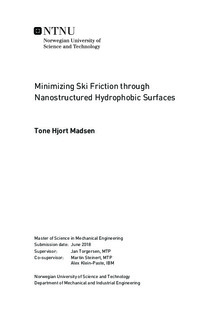Minimizing Ski Friction through Nanostructured Hydrophobic Surfaces
Master thesis
Permanent lenke
http://hdl.handle.net/11250/2561551Utgivelsesdato
2018Metadata
Vis full innførselSamlinger
Sammendrag
The correlation between ski friction and a ski base surface that can enhance hydrophobicity by geometry has been investigated. A review is given of existing knowledge about the linkage between ski friction mechanisms, generation of a water film between ski-and snow base, and wettability. The effect of roughness induced wettability is explained, and forms the basis of examining nanostructuring techniques to obtain a hydrophobic ski base. The fabrication of an anodic aluminum oxide (AAO) miniature ski prototype is reported, conducted with a simple and low-cost setup. Anodization is performed in a single step procedure with a constant current of 5.18 A for 40 minutes, and an electrolyte consisting of sulfuric acid, oxalic acid, and sodium chloride. The resulting porous surface structure was analyzed with SEM, and pore diameters measured to 20-33 nm. The contact angle (CA) was measured to 130° for the anodized sample when coated with PTFE. A reference sample with identical dimensions, but with a longitudinally milled surface, was fabricated and measured a CA of 92°, also when PTFE coated. Friction tests were performed with a Linear Analyzer of Road Surface (LARS) apparatus in which the samples were accelerated on a linear snow track at an indoor facility. The coefficient of friction (COF) was measured at a constant velocity of 2 m/s. Measurements were conducted on both anodized and reference sample at snow temperatures of -10 °C and -4.6 °C. The surfaces were analyzed with an optical profilometer (OP) and CA measured, both before and after friction tests. The results from the friction tests state that the anodized sample holds lowest COF at -10 °C, but the reference sample has lowest values at -4.6 °C. However, it is believed that the observed wear of PTFE is more critical for the AAO sample, and hence a clear conclusion cannot be stated on whether the nanoporous hydrophobic surface yields reduced friction compared to the reference sample.
